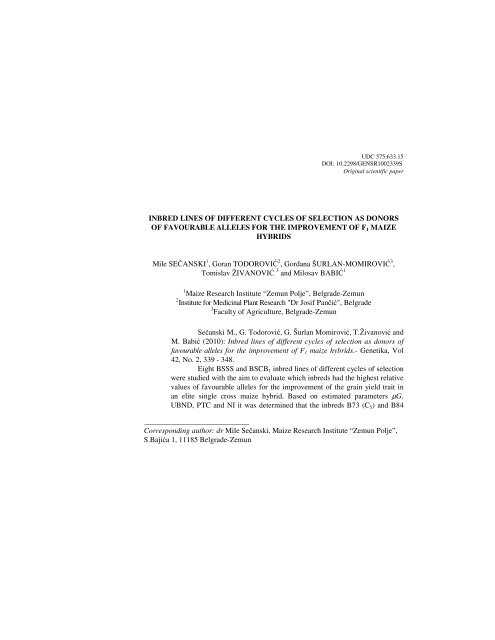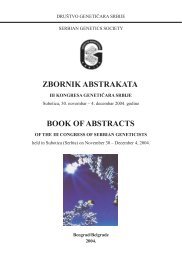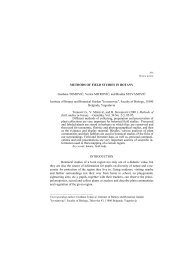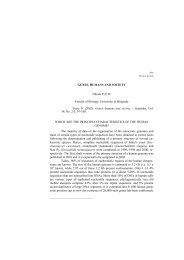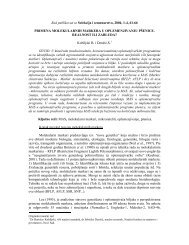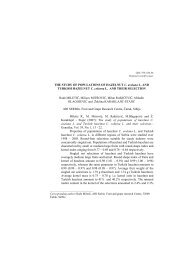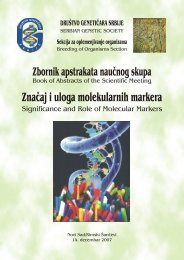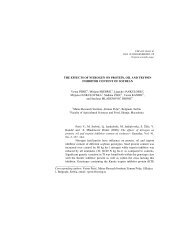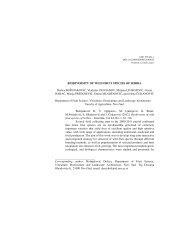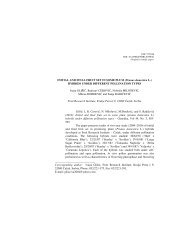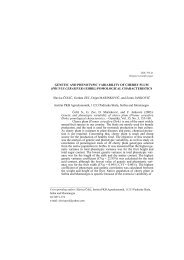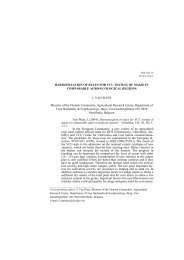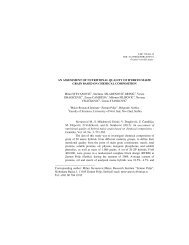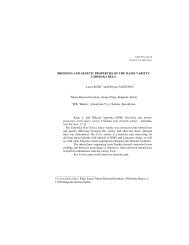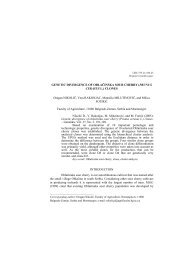dr Mile Sečanski, Maize Research Institute “Zemun Polje ... - doiSerbia
dr Mile Sečanski, Maize Research Institute “Zemun Polje ... - doiSerbia
dr Mile Sečanski, Maize Research Institute “Zemun Polje ... - doiSerbia
Create successful ePaper yourself
Turn your PDF publications into a flip-book with our unique Google optimized e-Paper software.
UDC 575:633.15<br />
DOI: 10.2298/GENSR1002339S<br />
Original scientific paper<br />
INBRED LINES OF DIFFERENT CYCLES OF SELECTION AS DONORS<br />
OF FAVOURABLE ALLELES FOR THE IMPROVEMENT OF F1 MAIZE<br />
HYBRIDS<br />
<strong>Mile</strong> SEČANSKI 1 , Goran TODOROVIĆ 2 , Gordana ŠURLAN-MOMIROVIĆ 3 ,<br />
Tomislav ŽIVANOVIĆ 3 and Milosav BABIĆ 1<br />
1 <strong>Maize</strong> <strong>Research</strong> <strong>Institute</strong> <strong>“Zemun</strong> <strong>Polje</strong>”, Belgrade-Zemun<br />
2 <strong>Institute</strong> for Medicinal Plant <strong>Research</strong> "Dr Josif Pančić", Belgrade<br />
3 Faculty of Agriculture, Belgrade-Zemun<br />
<strong>Sečanski</strong> M., G. Todorović, G. Šurlan Momirović, T.Živanović and<br />
M. Babić (2010): Inbred lines of different cycles of selection as donors of<br />
favourable alleles for the improvement of F1 maize hybrids.- Genetika, Vol<br />
42, No. 2, 339 - 348.<br />
Eight BSSS and BSCB1 inbred lines of different cycles of selection<br />
were studied with the aim to evaluate which inbreds had the highest relative<br />
values of favourable alleles for the improvement of the grain yield trait in<br />
an elite single cross maize hybrid. Based on estimated parameters µG,<br />
UBND, PTC and NI it was determined that the inbreds B73 (C5) and B84<br />
____________________________<br />
Corresponding author: <strong>dr</strong> <strong>Mile</strong> <strong>Sečanski</strong>, <strong>Maize</strong> <strong>Research</strong> <strong>Institute</strong> <strong>“Zemun</strong> <strong>Polje</strong>”,<br />
S.Bajića 1, 11185 Belgrade-Zemun
340 GENETIKA, Vol. 42, No. 2, 339-348, 2010<br />
(C7), originating form the synthetic population BSSS had highest number of<br />
favourable alleles for the improvement of the grain yield. Both these inbreds<br />
belong to the later cycles of recurrent selections and proved to be better<br />
donors of favourable alleles than inbreds belonging to the earlier cycles of<br />
selection. The rank correlations of used parameters were positive and highly<br />
significant, while the highest values of correlations for yield were<br />
determined between µG and NI, that is PTC and NI. The highest grain yield<br />
was recorded in the hybrid ZPL2 x B73, which also had the highest value of<br />
heterosis (174.9%) in the trial for estimation of loci relative values.<br />
Key words: donor of favourable alleles, heterosis, .inbred line,<br />
maize, rank correlation<br />
INTRODUCTION<br />
<strong>Maize</strong> hybrids have a reduced period of the utilisation in the contemporary<br />
agricultural production. Therefore, they have to be replaced by new hybrids that will<br />
exceed the existing ones in their performances. Ultimately, one of the objectives in<br />
maize breeding is to improve different traits in an elite hybrid as well as to improve<br />
agronomic traits of parental component without negative effects on grain yield of<br />
elite single cross. Classical methods, such as general combining ability (GCA)<br />
(SPRAGUE and TATUM, 1942) and predicted three way cross (PTC) (SPRAGUE and<br />
EBERHART, 1977), are known to be effective, regardless of the superior or inferior<br />
performance of the potential donors and recipients. Numerous statistical methods<br />
have been developed for identifying donors to improve elite hybrids, DUDLEY (1984,<br />
1987a, b) developed a statistical procedure for estimation of relative number of loci<br />
(µG) for which a donor line is different from each parent of the single cross to be<br />
improved. The model starts from the presumption that there is a complete<br />
domination a = 1 and z = −µ , wherefore the genotypic value + +, + − and − − of<br />
genotypes is z + 2 µ ; z + µ + a µ and z, where z is a value of the least favourable<br />
genotype − −, µ is one half of the difference in genotypic value between + + and − −<br />
genotypes, while a is a degree of domination. Moreover, this model implies that µ is<br />
constant for all loci and that there is no epistasis. Dominant alleles (positive value of<br />
µG) are favourable for the maize grain yield, and inbreds with the highest value of<br />
µG can be considered as a potentially good source of favourable alleles. Positive and<br />
high values of µG for donor inbred lines confirm the existence of new favourable<br />
alleles in these inbreds that parents of an elite hybrid do not include. The negative<br />
values of the relation µG - µD or µG - µF point to a number of loci for which inbred<br />
lines I1 and I2 carry favourable alleles, and Iw carries unfavourable alleles. If this<br />
number is higher than the number of loci for which inbred lines I1 and I2 carry<br />
unfavourable alleles, and Iw carries favourable alleles, it is necessary to perform a<br />
backcross of the F1 generation (parent inbred x donor inbred) to parent inbred I1 or<br />
I2. If, on the other hand, the difference µG - µD or µG - µF is not significantly<br />
different from 0, the direct self-pollination of F2 generation is recommended in the<br />
process of selection. Positive values of the difference µG - µD or µG - µF lead to a
M. SEČANSKI et al.: INBRED LINES AS DONOR OF FAVORABLE ALLELS 341<br />
conclusion that if the number of loci for which inbred lines I1 and I2 carry<br />
unfavourable alleles and Iw carries favourable is higher than the number of loci for<br />
which inbreds I1 and I2 carry favourable alleles and the inbred Iw carries<br />
unfavourable alleles, the backcross of the F1 generation to the donor inbred (Iw) is<br />
recommended.<br />
GERLOFF and SMITH (1988a.b) proposed an estimate of a minimum upper<br />
bound on µG (UBND). BERNARDO (1990) presented an estimate of the relative<br />
number of favourable alleles that can be gained from the inbred minus the relative<br />
number of favourable alleles that can be lost from the parents of the hybrid during<br />
selection (NI), while METZ (1994) published two estimates of the relative number of<br />
loci where favourable alleles can be either gained or lost.<br />
The improvement of existing hybrids, i.e. the improvement of one or both<br />
parent inbred lines of an elite hybrid, is one of methods of developing new improved<br />
maize hybrids. The procedure implies the introduction of favourable alleles into the<br />
existing inbreds, which will result in better agronomic traits and improved yield<br />
potential of the new hybrids. Most frequently, inbred lines have been used as donors<br />
of favourable alleles for the improvement of qualitative and quantitative traits of<br />
single cross hybrids.<br />
The objective of the present study was to estimate which of observed BSSS<br />
and BSCB1 inbred lines of different cycles of selection have the highest relative<br />
values as donors of favourable alleles for the improvement of grain yield of an elite<br />
maize hybrid. Estimation of number of favourable alleles in inbred donor lines (Iw)<br />
that are not present in elite single cross hybrid (I1 x I2) was done based on four<br />
parameters: µG, UBND (upper bound estimates), PTC (predicted three way cross)<br />
and NI (net improvement statistics). For the improvement of grain yield of elite<br />
single cross hybrid ZP 580, efficiency of each used parameter was estimated<br />
separately. Comparison between used parameters was done using Spearman's rank<br />
correlation coefficient. Obtained results can be of importance for the further work on<br />
maize breeding, as it is, based on them, possible to select donor inbreds of<br />
favourable alleles for the grain yield, which consequently would lead to increased<br />
efficiency of breeding.<br />
MATERIALS AND METHODS<br />
Selected maize inbred lines of different cycles of recurrent selection belong<br />
to the following two synthetic populations: BSSS and BSCB1. Inbreds B14(C0),<br />
B37(C0), B73(C5) and B84(C7) were derived from the Iowa Stiff Stalk Synthetic<br />
(BSSS), while inbreds B90(C7), B91(C8), B97(C9) and B99(C10) were developed<br />
from the Corn Borer Synthetic No.1 (BSCB1). Inbred lines derived from both<br />
synthetics were crossed to parental inbred lines of the hybrid ZP 580 (ZPL1 and<br />
ZPL2). During two years, the following two trials in two locations (Zemun <strong>Polje</strong> and<br />
Kraljevci) were set up to estimate the relative value of loci: a trial with hybrids and a<br />
trial with donor inbred lines and parental inbred lines of the hybrid ZP 580 which<br />
was in the process of improvement. The trials were set up according to the complete
342 GENETIKA, Vol. 42, No. 2, 339-348, 2010<br />
randomised block design with four replications. The elementary plot size was 3.36 m 2 ,<br />
while crop density was 59,500 plants ha -1 .<br />
The estimation of a relative number of favourable alleles of observed<br />
inbreds in relation to an elite single cross hybrid (hybrid selected to be improved) for<br />
the observed traits was done according to the model developed by DUDLEY (1987a,<br />
b).<br />
Besides the parameter µG, the following parameters for inbred lines were<br />
used in the study: UBND (GERLOF and SMITH, 1988), PTC (HALLAUER and<br />
MIRANDA, 1988) and NI (BERNARDO, 1990 a, b).<br />
UBND estimator is defined as a minimum of the two equations (I1 x Iw) - I1<br />
and (I2 x Iw) - I2, which have a prediction of 2µE + 2µG and 2µC + 2µG,<br />
respectively.<br />
PTC is a predicted three way crosses performance that is estimated as [(I1 x<br />
Iw) + (I2 x Iw)] / 2 and has a prediction of N (z + µ) + µ(A + B + C + E + G - H)<br />
where N is a total number of loci that affect observed trait.<br />
Net improvement (NI) estimates the number of loci where favourable alleles<br />
can be added (minus the number of loci where they can be lost) in an elite hybrid.<br />
This estimator is calculated as a maximum value of the formula [(I1 x Iw) - (I1 x I2)] /<br />
2 or [(I2 x Iw) - (I1 x I2)] / 2. The used estimators were compared among themselves<br />
by Spearman's rank correlation coefficient (HADŽIVUKOVIĆ, 1991).<br />
Heterosis (H) for grain yield was calculated in relation to a superior<br />
parent.<br />
RESULTS<br />
The highest, i.e. lowest grain yield was recorded in the hybrids ZPL2 x<br />
B73 (10.908 t ha -1 ), i.e. the hybrid ZPL2 x B91 (8.730 t ha -1 ), respectively. The mean<br />
values of inbred line yields ranged from 4.932 t ha -1 in the inbred B84(C7) to 1.783 t<br />
ha -1 in the inbred B99(C10) (Table 1.). The inbred line ZPL1 had higher average<br />
grain yield (4.394 t ha -1 ) than the second parent of the elite single cross hybrid,<br />
inbred line ZPL2 (3.967 t ha -1 , Table 1).<br />
All observed inbred lines have positive and significant values of the<br />
parameter µG for grain yield, meaning that they can be donors of new favourable<br />
alleles which are not contained by the parents of the elite single cross hybrid ZPL1 x<br />
ZPL2. The highest values of this parameter were recorded in the inbreds B73 (C5),<br />
B84 (C7) and B97 (C9) of later cycles of selection, while the lowest value of the<br />
parameter was detected in the inbred B14 (C0) that belongs to the initial cycle of<br />
selection (Table 2). The significant values of the parameter µG and importance of<br />
donors for breeding programmes were presented in studies carried out by DUDLEY<br />
(1984 a), MIŠEVIĆ (1989 a, b), ZANONI and DUDLEY (1989 a), METZ (1994), BABIĆ et<br />
al. (1996), VRAČAREVIĆ (2000), TRIFUNOVIĆ et al. (2001), ROSA et al. (2001),<br />
MALVAR et al. (2004), AVILA et al. (2005), ŽIVANOVIĆ et al. (2006) and SEČANSKI et<br />
al. (2009).<br />
AVILA et al. (2005) reported possibility of improvement of grain yield in<br />
three single cross hybrids with use of tropical inbred lines as donors of favourable
M. SEČANSKI et al.: INBRED LINES AS DONOR OF FAVORABLE ALLELS 343<br />
alleles. In their research, progenitors of three single cross hybrids were crossed with<br />
23 inbred lines with the purpose of identifying best donor lines for improving grain<br />
yield of tropical single cross hybrids. They identified three tropical (CML258,<br />
CML264, CML273) and three subtropical inbred lines (CML311, CML312,<br />
CML319) as the donors with highest frequencies of favourable alleles.<br />
Table 1. Grain yield (t ha -1 ) of 10 inbred lines and 17 maize hybrids and heterosis<br />
Inbred lines and their hybrids (F1) Grain yield (t ha -1 ) Heterosis %<br />
ZPL1 4.394<br />
ZPL2 3.967<br />
B14(C0) 2.899<br />
B37(C0) 2.256<br />
B73(C5) 3.801<br />
B84(C7) 4.932<br />
B90(C7) 2.078<br />
B91(C8) 2.193<br />
B97(C9) 4.298<br />
B99(C10) 1.783<br />
ZPL1 x ZPL2 10.741 144.4 **<br />
ZPL1 x B14(C0) 9.012 105.1 **<br />
ZPL1 x B37(C0) 8.896 102.5 **<br />
ZPL1 x B73(C5) 10.236 132.9 **<br />
ZPL1 x B84(C7) 9.938 101.5 **<br />
ZPL1 x B90(C7) 8.811 100.5 **<br />
ZPL1 x B91(C8) 9.117 107.5 **<br />
ZPL1 x B97(C9) 9.945 126.3 **<br />
ZPL1 x B99(C10) 9.889 125.1 **<br />
ZPL2 x B14(C0) 8.956 125.8 **<br />
ZPL2 x B37(C0) 9.546 140.6 **<br />
ZPL2 x B73(C5) 10.908 174.9 **<br />
ZPL2 x B84(C7) 10.765 118.3 **<br />
ZPL2 x B90(C7) 9.340 135.4 **<br />
ZPL2 x B91(C8) 8.730 120.1 **<br />
ZPL2 x B97(C9) 9.695 125.6 **<br />
ZPL2 x B99(C10) 9.670 143.8 **<br />
t0.05=2.042 t0.01=2.750<br />
Genetic relatedness of donor inbreds to parent inbreds was evaluated over<br />
the expression (µC+µF)-(µD+µE), DUDLEY (1984 a), whereby positive, i.e.
344 GENETIKA, Vol. 42, No. 2, 339-348, 2010<br />
negative, values suggest a greater relatedness to the inbred ZPL1, i.e. the inbred<br />
ZPL2, respectively.<br />
The inbred lines B37 (C0), B73 (C0), B84 (C7) and B90 (C7) had<br />
significant and positive values of the expression (µC+µF)-(µD+µE) and showed<br />
greater relatedness to the inbred line ZPL1. A positive, but not significant value was<br />
expressed by the inbred B14 (C0). The inbreds B91 (C8), B97 (C9) and B99 (C10),<br />
belonging to the higher cycles of selection of BSCB1, had negative values and<br />
expressed greater relatedness to the inbred ZPL2 (Table 2).<br />
Table 2. The estimation of a relative number of favourable alleles for grain yield<br />
Donors<br />
(Iw)<br />
µG<br />
Relatedness<br />
(µC+µF)-(<br />
µD+µE)<br />
µG-(µDor µF)<br />
Cross<br />
method<br />
B14(C 0) 0,722 * 0,157 -0,892 * (I 1 x Iw) x I 1<br />
B37(C 0) 0,827 * 0,863 * -0,597 * (I 1 x Iw) x I 1<br />
B73(C 5) 1,502 * 0,885 * 0,083 Self<br />
B84(C 7) 1,392 * 1,040 * 0,012 Self<br />
B90(C 7) 0,754 * 0,742 * -0,700 * (I 1 x Iw) x I 1<br />
B91(C 8) 0,775 * -0,173 -0,812 * (I 2 x Iw) x I 2<br />
B97(C 9) 1,189 * -0,037 -0,398 * (I 2 x Iw) x I 2<br />
B99(C 10) 1,161 * -0,009 -0,426 * (I 2 x Iw) x I 2<br />
* > 2SE<br />
Inbred lines B73(C5) and B84(C7) expressed high values of the parameter<br />
µG but their differences µG-(µD or µF) were no significantly higher than 0 (Table<br />
2). This suggests that direct self-pollination and selection of inbred lines from<br />
crosses (ZPL1 x B73) and (ZPL1 x B84) can be done, as both donor inbreds showed<br />
relatedness to the inbred ZPL1. Other two inbreds, B97 (C9) and B99 (C10), had<br />
positive and significant values of favourable alleles for the grain yield that were not<br />
present in the elite hybrid ZPL1 x ZPL2. The number of recessive unfavourable<br />
alleles was significantly higher in both inbreds, hence the F1 generation should, in<br />
the process of selection for this trait, be backcrossed to the parent inbred ZPL2, as<br />
they showed relatedness to this inbred line (Table 2).<br />
The value of µD was significantly higher than the value of µG for the<br />
inbred B14 (C0), while the value of µF was significantly higher than the value of µG<br />
for the inbred B91 (C8). It means that the number of unfavourable, recessive alleles<br />
for grain yield in observed donor inbred lines were significantly higher than the<br />
number of favourable, dominant alleles. In order to avoid the introduction of<br />
unfavourable alleles, the backcross of F1 generation ZPL1 x B14 to the inbred ZPL1<br />
that is ZPL2 x B91 to the inbred ZPL2 is recommended. Donor inbred lines B37(C0)
M. SEČANSKI et al.: INBRED LINES AS DONOR OF FAVORABLE ALLELS 345<br />
and B90(C7) had a significantly higher frequency of unfavourable recessive alleles<br />
than a frequency of favourable dominant alleles, hence in this case backcross of F1<br />
generation should be done to the parent ZPL1 (Table 2).<br />
Ranking of the donor inbred lines on the basis of their values estimated<br />
over four used parameters shows a good agreement among parameters µG, UBND,<br />
PTC and NI. All four parameters identically ranked the first four best ranked inbred<br />
lines (Table 3), even KUMAR et al. (2003), reported µG and UBND as the best<br />
estimates in ranking donor inbred lines. The stated results are confirmed by high and<br />
significant values of the rank correlation (Table 4).<br />
Table 3. The estimation and rank of µG*, UBND, PTC and NI for grain yield<br />
Donor line µG UBND PTC NI<br />
B14(C 0) 0.722 (8) 4.618 (6) 8.984 (7) -0.864 (8)<br />
B37(C 0) 0.827 (5) 4.502 (7) 9.221 (5) -0.597 (5)<br />
B73(C 5) 1.502 (1) 5.842 (1) 10.572 (1) 0.083 (1)<br />
B84(C 7) 1.392 (2) 5.544 (3) 10.351 (2) 0.012 (2)<br />
B90(C 7) 0.754 (7) 4.417 (8) 9.075 (6) -0.700 (6)<br />
B91(C 8) 0.775 (6) 4.723 (5) 8.923 (8) -0.812 (7)<br />
B97(C 9) 1.189 (3) 5.551 (2) 9.820 (3) -0.398 (3)<br />
B99(C 10) 1.161 (4) 5.495 (4) 9.778 (4) -0.426 (4)<br />
Values of the rank are given within the brackets<br />
Table 4. Rank correlation for grain yield<br />
µG UBND PTC NI<br />
µG * * 0.857 * 0.928 ** 0.976 **<br />
UBND * 0.762 * 0.786 *<br />
PTC * 0.976 **<br />
NI *<br />
*p
346 GENETIKA, Vol. 42, No. 2, 339-348, 2010<br />
study was to compare realised results and predictions of methods to identify potential<br />
donors for improving agronomic performance of sweet corn hybrids. Yield and three<br />
agronomic traits were recorded. Inbred lines A632 and EP42 were identified as the<br />
best potential donors for improving yield and several yield components of sweet corn<br />
hybrids in their study. The use of EP42 would reduce row number, while the use of<br />
W64A would reduce yield and ear length. The estimator µG correctly predicted the<br />
best donor of favourable alleles for improving yield and agronomic performance of<br />
sweet corn hybrids. Realised response, however, did not coincide with predictions,<br />
particularly with ranking of donors, while predictions of best recipient fitted the<br />
realised results.<br />
CONCLUSION<br />
The highest grain yield (10.908 t ha -1 ) was recorded in the hybrid ZPL2 x<br />
B73. At the same time, this hybrid, in the trial for the evaluation of relative values of<br />
loci, showed the highest heterosis (174.9%).<br />
Based on estimated parameters: µG, UBND, PTC and NI it was possible to<br />
evaluate studied inbred lines as donors of favourable alleles for the improvement of<br />
the observed hybrid. The donor inbred lines for the improvement of the grain yield in<br />
the hybrid ZPL1 x ZPL2 showed greater genetic relatedness to the female parent,<br />
inbred line ZPL1. Inbred lines belonging to the higher cycles of recurrent selection<br />
of studied synthetics were better donors of favourable alleles than inbred lines<br />
belonging to the initial cycles, indicating that the relative number if favourable<br />
alleles increased during the selection in both populations (BSSS and BSCB1).<br />
The inbred line B73 (C5) had the greatest number of favourable dominant<br />
alleles for the improvement of the grain yield of the hybrid ZPL1 x ZPL2.<br />
Furthermore, the inbred B84 (C7) was a good donor of favourable alleles for grain<br />
yield. As both inbreds showed relatedness to the inbred ZPL1, direct self-pollination<br />
and selection of inbreds derived from crosses ZPL1 x B73 and ZPL1 x B84 can be<br />
recommended for the process of selection. The inbreds B97 (C9) and B99 (C10) were<br />
closer to the inbreed ZPL2 and had positive and significant values of favourable<br />
alleles for the grain yield that were not present in the elite hybrid ZPL1 x ZPL2. The<br />
number of recessive unfavourable alleles was greater in these inbreds than in the<br />
inbreds B73 (C5) and B84 (C7), hence the backcross of the F1 generation (ZPL2 x<br />
B97; ZPL2 x B99) should be done to the male parent of the elite hybrid (ZPL2) in<br />
the process of selection for grain yield.<br />
The rank correlations among parameters µG, PTC and NI were positive and<br />
highly significant, while the rank correlations between UPBND and remaining<br />
observed parameters (µG, PTC and NI) were positive and significant.<br />
Received February 10 th , 2010<br />
Accepted June 22 th , 2010
M. SEČANSKI et al.: INBRED LINES AS DONOR OF FAVORABLE ALLELS 347<br />
REFERENCES<br />
ASORO, F.G., A.M. SALAZAR, A.L. CARPENA and N.C. ALTOVEROS (2007): Identification of donors with<br />
favorable allels for grain yield to improve inbreds in a Philippine maize breding program,<br />
Philippine Agricultural Scientist, 90(1), 54-63.<br />
AVILA, N.V., S.A.R. HERRERA and H.C. ORELLANA (2005): Evaluacion de lineas tropicales de maiz (zea<br />
mays) como fuente de alelos favorables para mejorar hibridos simples elites, Agonomia<br />
Mesoamericana 16(2); 127-136.<br />
BABIĆ, M., N. DELIĆ Z.PAJIĆ and G.TODOROVIĆ (1996): Identification of donors containing favourable<br />
alleles for grain yield and popping volume in pop corn (Zea mays L. everta). Genetika, Vol.<br />
28, No. 1:17-21.<br />
BERNARDO, R. (1990a): An alternative statistics for identifying lines useful for improving parents of an<br />
elite single cross, Theor. Appl. Genet., 80, 105-109.<br />
DUDLEY, J. W. (1984 a): A method of indentifying lines for use in improving parents of a single cross,<br />
Crop Sci. 24, 355-357.<br />
DUDLEY, J. W. (1987 a): Modification of methods for identifying inbred lines useful for improving parents<br />
of an elite single crosses, Crop Sci. 27, 944-947.<br />
DUDLEY, J. W. (1987 b): Modification of methods for identifying populations to be used for improving<br />
parents of an elite single crosses, Crop Sci. 27, 940-943.<br />
GERLOF, J. E. and O. S. SMITH (1988): Choice of method for identifying germplasm with superior alleles,<br />
Theor. Appl. Genet. 76, 209-216.<br />
FABROUOIS, M. A. and S. J. OPENSHOW (1994): Methods to evaluate populations for alleles to improve an<br />
elite hybrid, Theor. Appl. Genet. 88, 653-661.<br />
HADŽIVUKOVIĆ, S. (1991): Statistical methods, University in Novi Sad, Agricultural Faculty, Novi Sad.<br />
HALLAUER, A. R. and J. B. MIRANDA (1988): Quantitative genetics in maize breeding, 2 nd ed. Iowa State<br />
University Press, Ames, Iowa, pp 361-362.<br />
MALVAR, R.A., M.E. CARTEA, P.REVILLA, S. SOENGA, and A.ORDAS, (2004): Verification of predictions from<br />
estimators of favourable alleles to improve yield of sweet corn hybrids, Maydica, 49, 49-55.<br />
KUMAR M., S. VENKATESH and E.SATYANARAYANA (2003): Comparison of methods to identify donor<br />
inbreds with favourable alleles for the improvement of elite maize single cross hybrids. Indian<br />
Journal of Genetics and Plant Breeding, 63, 3<br />
METZ, G. (1994): Probability of net grain of favourable alleles for improving an elite single cross, Crop<br />
Sci. 34, 668-672.<br />
MIŠEVIĆ, D. (1989 a): Evaluation of three test statistics used to identify maize inbred lines with new<br />
favourable alleles not present in an elite single cross, Teor. Apll. Genet. 77, 402-408.<br />
MIŠEVIĆ, D.(1989 b): Identification of inbred lines as a source of new alleles for improvement of elite<br />
maize single crosses, Crop Sci. 29, 1120-1125.<br />
REDDY, D.M., V.P. AHUJA and B.K. MUKHERJEE (2005): Comparison of various statistics for identification<br />
of maize inbreds with favourable alleles for the improvement of single cross hybrid in maize<br />
(Zea mays L.), The Indian Journal of Genetics and Plant Breeding, Volume 65. Issue 4.<br />
ROSA, A. M., R. PEDRO, E.C.,MARIA, M.B. ANA, and O. AMONDO (2001): Checking performance of field corn<br />
inbreds as donors of favourable alleles to improve early and adaptation od sweet corn hybrids<br />
to European conditions, Maydica, 46,187-193.
348 GENETIKA, Vol. 42, No. 2, 339-348, 2010<br />
SEČANSKI, M., T. ŽIVANOVIĆ, G. ŠURLAN-MOMIROVIĆ, S. PRODANOVIĆ and S. JOVANOVIĆ (2009):<br />
Combining abilities for yield maize of lines from different selection cycles. Book of Abstracts<br />
of the IV Congress of Serbian Geneticists, Tara June 1 st 5 th ,201.<br />
TRIFUNOVIĆ, S., I. HUSIĆ, M.ROŠULJ and R.STOJŠIN (2001): Evaluation of U. S. and Yugoslavian <strong>Maize</strong><br />
Populations as Sources of Favourable Alleles, Crop Sci. 41:302-308.<br />
VRAČAREVIĆ, M., J.DAMJANOVIĆ, and S.PRODANOVIĆ (2000): Identification of inbreds as donors of<br />
favourable alleles for grain yield in the elite hybrid ZPE 25-10-1 x B84 of maize, Plant<br />
Breeding and Seed Production, Vol. 7, br. 3-4.<br />
ZANONI, U. and J. W. DUDLEY (1989 a): Comparison of different methods of identifying inbreds useful for<br />
improving elite maize hybrids, Crop Sci. 29, 577-582.<br />
ŽIVANOVIĆ, T., S. VUČKOVIĆ, S. PRODANOVIĆ and G.TODOROVIĆ (2006): Evaluation of inbred lines as<br />
sources of new alleles for improving elite maize hybrid, Cereal <strong>Research</strong> Communications,<br />
Vol. 34 Nos. 2-3.<br />
INBRED LINIJE IZ RAZLIČITIH CIKLUSA SELEKCIJE DONORI<br />
POŽELJNIH ALELA ZA POPRAVKU F1 HIBRIDA KUKURUZA<br />
<strong>Mile</strong> SEČANSKI 1 , Goran TODOROVIĆ 2 , Gordana ŠURLAN-MOMIROVIĆ 3 ,<br />
Tomislav ŽIVANOVIĆ 3 , Milosav BABIĆ 1<br />
1 Institut za kukuruz "Zemun <strong>Polje</strong>", Beograd – Zemun<br />
2 <strong>Institute</strong> for Medicinal Plant <strong>Research</strong> "Dr Josif Pančić"<br />
3 Faculty of Agriculture, Belgrade-Zemun<br />
I z v o d<br />
Ispitivano je osam inbred linija različitih ciklusa selekcije poreklom iz<br />
BSSS i BSCB 1 izvora sa ciljem da se oceni koja ima najveće relativne vrednosti<br />
poželjnih alela za popravku osobine prinos zrna kod elitnog dvolinijskog hibrida<br />
kukuruza. Na osnovu izračunatih parametara µG*, UBND, PTC i NI utvrđeno je da<br />
najveći broj poželjnih dominantnih alela za popravku prinosa zrna pokazale su<br />
inbred linije B73(C 5) i B84(C 7) iz sintetičke populacije BSSS. Obe ove linije su iz<br />
kasnijih ciklusa rekurentne selekcije i pokazale su se kao bolji donori poželjnih alela<br />
u odnosu na linije iz ranijih ciklusa. Korelacije ranga između korišćenih parametara<br />
bile su pozitivne i visoko značajne, dok su najveće vrednosti korelacije za prinos<br />
utvrđene između µG* i NI, odnosno PTC i NI. Najveći prinos zrna je imao hibrid<br />
ZPL2 x B73 koji je u ogledu za procenu relativne vrednosti lokusa pokazao i najveću<br />
vrednost heterozisa (174,9%).<br />
Primljeno 10. II. 2010.<br />
Odobreno 22. VI. 2010.


